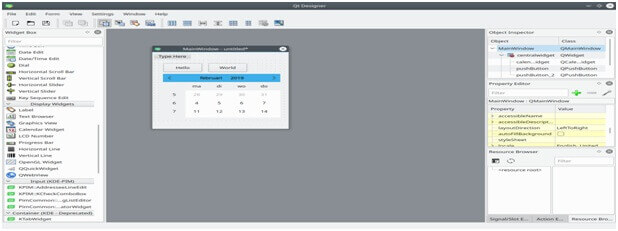

- #Qt creator python how to#
- #Qt creator python software#
- #Qt creator python download#
- #Qt creator python windows#
Self.btn_change_color = QPushButton("Roll Color")

# the widget will dispose itself according to the layout rules he's

# inherits from QDialog and from MovableWidget so we can have its properties.Ĭlass CustomDialog(QDialog, MovableWidget): lta = self.mapToGlobal()ĭef mouseReleaseEvent(self, QMouseEvent): If self.pressing : #and QMouseEvent.type() = Qt.LeftButton # You can Verify if it's also the left button and some other things #to make sure you are holding mouse button down #the pos of the widget when you first pressed it. # not just in terms of appearance but also behavioral. # overriding the three next methods is a way to customize your Widgets Here are some random examples with some comments along approaching the 3 topics I mentioned above: import random Note: In case of non Widget objects you will not be able to set a StyleSheet so you will have to override some paint methods, create your own Painters and so on.
#Qt creator python how to#
You can find more information here.In the following it is shown how to implement a QStackedWidget with 2 buttons, the basic idea is to layout the design, for this we analyze that a QVBoxLayout must be placed to place the QStackedWidget and another layout, this second layout will be a QHBoxLayout to have the buttons. It is a powerful IDE that provides basic templates to create new projects. Now you should know how to set up the Qt Creator application and run Python programs in Qt Creator. Here, we have used a simple Python program to print Hello World in Qt Creator. Write your Python script in the main.py file and run it to see the output. Otherwise, leave it as None and click Finish to continue. You can add the version control (Git) if you need. Next, enter the Python project’s name and location. In Qt Creator, select Create Project > Application (Qt for Python) > Empty Application and hit the Choose button. The installation time depends on your internet connection.Īfter the installation is successful, launch the Qt Creator application.ĭevelop Python Applications in Qt Creator Then select the installation folder where you want to save the Qt Creator files. You can choose whether to allow tracking of pseudonymous usage statistics in Qt Creator. Next, you will have to verify your email address.Īfter logging in, check both boxes and click Next to continue the installation. If you don’t have an account, click Sign up and create a new Qt account. The initial step is to log in to the Qt account. Then open the installer file and go through all the installation steps.
#Qt creator python download#
You can download Qt Creator from its official site. This tutorial will teach you to develop Python applications using the Qt Creator application.
#Qt creator python windows#
It runs on Linux, macOS, and Windows operating systems.
#Qt creator python software#
Qt Creator is a cross-platform IDE that lets you create software for desktop, embedded and mobile devices.


 0 kommentar(er)
0 kommentar(er)
